How to Identify Sports Cards With AI
Introducing sports card recognition API for card collector shops, apps, and websites.

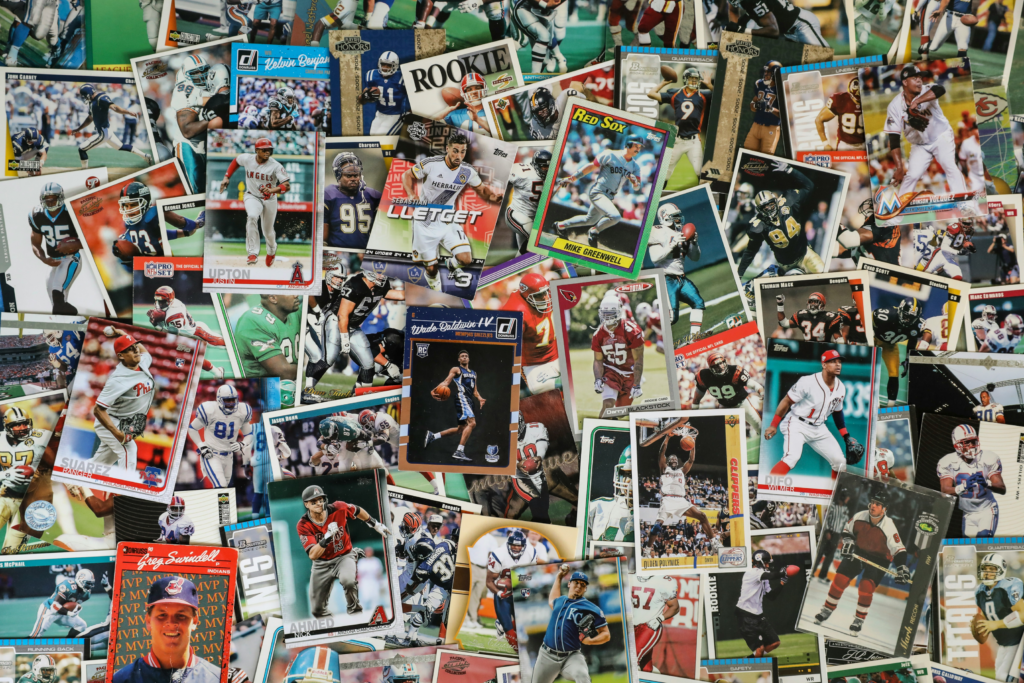
We have huge news for the collectors and collectibles marketplaces. Today, we are releasing an AI-powered system able to identify sports cards. It was a massive amount of work for our team, and we believe that our sports card identification API can benefit a lot of local shops, small and large businesses, as well as individual developers who aim to build card recognition apps.
Sports Cards Collecting on The Rise
Collecting sports cards, including hockey cards, has been a popular hobby for many people. Especially during my childhood, I collected hockey cards, as a big fan of the sport. Today, card collecting has evolved into an investment, and many new collectors enter the community solely to buy and sell cards on various marketplaces.
Some traditional baseball rookie cards can have significant value, for example, the estimated price of a vintage Mickey Mantle PSA 10 1952 Topps rookie baseball card is $15 million – $30 million.
Our Existing Solutions for Card Collector Sites & Apps
Last year, we already released several services focused on trading cards:
First, we released a Trading Card Game Identifier API. It can identify trading card games (TCGs), such as Pokémon, Magic The Gathering: MTG and Yu-Gi-Oh!, and more. We believe that this system is amongst the fastest, most precise and accurate in the world.
Second, we built a Card Grading and fast Card Conditioning API for both sports and trading card games. This service can instantly evaluate each corner, edges, and surface, and check the centring in a card scan, screenshot or photo in a matter of seconds. Each of these features is graded independently, resulting in an overall grade. The outputs can be both values or conditions-based (eBay or TCGPlayer naming). You can test it here.
We have also been building custom visual search engines for private collections of trading cards and other collectibles. With this feature, people can visit marketplaces or use their apps to upload card images, and effortlessly search for identical or similar items in their database with a click. Visual search is a standard AI-powered function in major price comparators. If a particular game is not on our list, or if you wish to search within your own collection, list, or portfolio of other collectibles (e.g., coins, stamps, or comic books), we can also create it for you – let us know.
We have been gradually establishing a track record of successful projects in the collectibles field. From the feedback of our customers, we hear that our services are much more precise than the competition. So a couple of months ago, we started building a sports card scanning system as well. It allows users to send the scan to the API, and get back precise identification of the card.
Our API is open to all developers, just sign up to Ximilar App, and you can start building your own great product on top of it!
Test it Now in Live Demo
This solution is already available for testing in our public demo. Try it for free now!
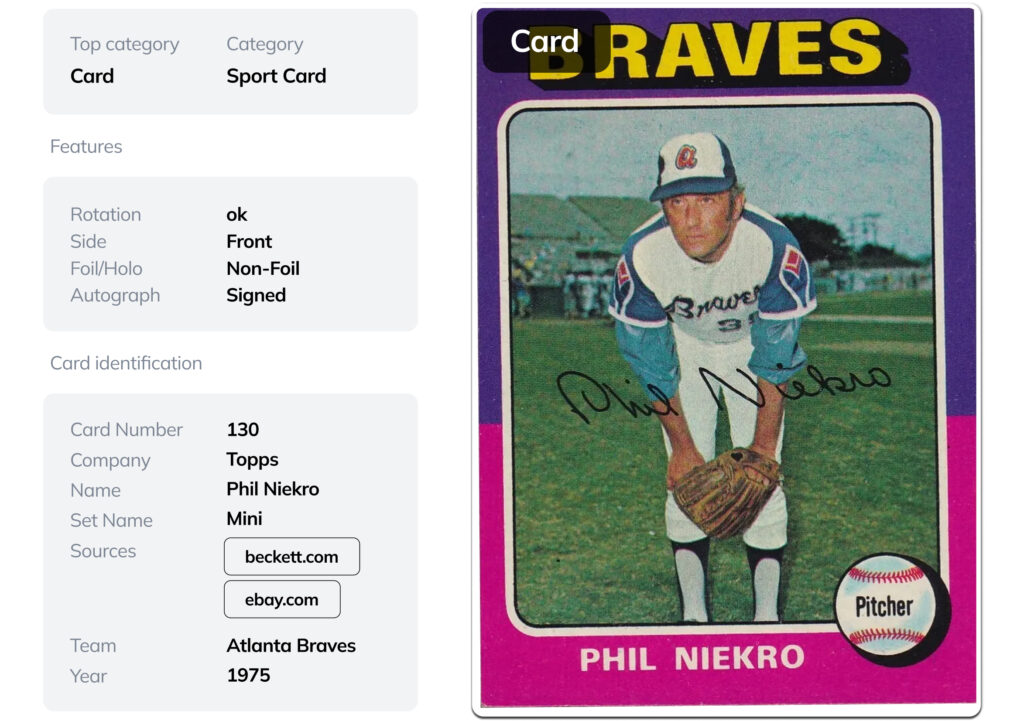
The Main Features of Sports Cards
There are several factors determining the value of the card:
Rarity & Scarcity: Cards with limited production runs or those featuring star players are often worth more.
Condition: Like any collectible item, the condition of a sports card is crucial. Cards in mint or near-mint condition are generally worth more than those with wear and tear.
Grade & Grading services: Graded cards (from PSA or Beckett) typically have higher prices in the market.
The fame of the player: Names of legends like Michael Jordan or Shohei Ohtani instantly add value to the trading cards in your collection.
Autographs, memorabilia, and other features, that add to the card’s rarity.
Each card manufacturer must have legal rights and licensing agreements with the sports league, teams, or athletes. Right now, there are several main producers:
Panini – This Italian company is the largest player in the market in terms of licensing agreements and number of releases.
Topps – Topps is an American company with a long history. They are now releasing cards from Baseball, Basketball or MMA.
Upper Deck – Upper Deck is a company with an exclusive license for hockey cards from the NHL.
Futera – Futera focuses mostly on soccer cards.

Dozens of other card manufacturers were acquired by these few players. They add their brands or names as special sets in their releases. For example, the Fleer company was acquired by Upper Deck in 2005 and Donruss was bought by Panini.
Identifying Sports Cards With Artificial Intelligence
When it comes to sports cards, it’s crucial to recognize that the identification challenge is more complex than that of Pokémon or Magic The Gathering cards. While these games present challenges such as identical trading card artworks in multiple sets or different language variants, sports cards pose distinct difficulties in recognition and identification, such as:
Amount of data/cards – The companies add a lot of new cards into their portfolio each year. As of the latest date, the total figure exceeds tens of millions of cards.
Parallels, variations, and colours – The card can have multiple variants with different colours, borders, various foil effects, patterns, or even materials. More can be read in a great article by getcardbase.com. Look at the following example of the NBA’s LeBron James card, and some of its variants.

Special cards: Short Print (SP) and Super Short Print (SSP) cards are intentionally produced in smaller quantities than the rest of the particular set. The most common special cards are Rookie cards (RC) that feature a player in their rookie season and that is why they hold sentimental and historical value.
Serial numbered cards: A type of trading cards that have a unique serial number printed directly on the card itself.
Authentic signature/autograph: These are usually official signature cards, signed by players. To examine the authenticity of the signature, and thus ensure the card’s value, reputable trading card companies may employ card authentication processes.
Memorabilia: In the context of trading cards, memorabilia cards are special cards that feature a piece of an athlete’s equipment, such as a patch from a uniform, shoe, or bat. Sports memorabilia are typically more valuable because of their rarity. These cards are also called relic cards.
As you can see, it’s not easy to identify the card and its price and to keep track of all its different variants.
Example: Panini Prizm Football Cards
Take for example the 2022 Panini Prizm Football Cards and the parallel cards. Gold Prizms (10 cards) are worth much more than the Orange Prizms (with 250 cards) because of their scarcity. Upon the release of a card set, the accompanying checklist, presented as a population table, is typically made available. This provides detailed information about the count for each variation.
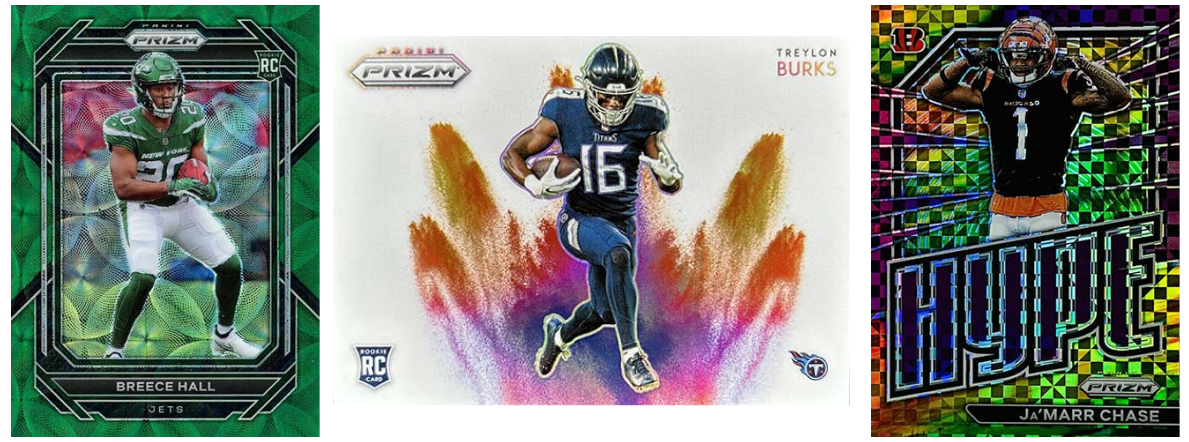
Next, for Panini Prizm, there are more than 20 parallel foil patterns like Speckle, Hyper, Diamond, Fast Break/Disco/No Huddle, Flash, Mozaic, Mojo, Pulsar, Shimmer, etc. with all possible combinations of colours such as green, blue, pink, purple, gold, and so on.
These combinations matter because some of them are more rare than others. There are also different names for the foil cards between companies. Topps has chrome Speckle patterns which are almost identical to the Panini Prizm Sparkle pattern.
Lastly, no database contains each picture for every card in the world. This makes visual search extremely hard for cards that have no picture on the internet.

Luckily, we developed (and are actively improving) an AI service that is trying to tackle the mentioned problems with sports cards identification. This service is available on click as an open REST API, so anyone can connect to develop and integrate their system with ours. The results are in seconds and it’s one of the fastest services available in the market.
How to Identify Sports Cards Via API?
In general, you can use and connect to the REST API with any programming language like Python or Javascript. Our developer’s documentation will serve you as a guide with many helpful instructions and tips.
To access our API, sign in Ximilar App to get your unique API authentication token. You will find the administration of your services under Collectibles Recognition. Here is an example REST Request via curl:
$ curl https://api.ximilar.com/collectibles/v2/sport_id -H "Content-Type: application/json" -H "Authorization: Token __API_TOKEN__" -d '{
"records": [
{ "_url": "__PATH_TO_IMAGE_URL__"}
], "slab_id": false
}'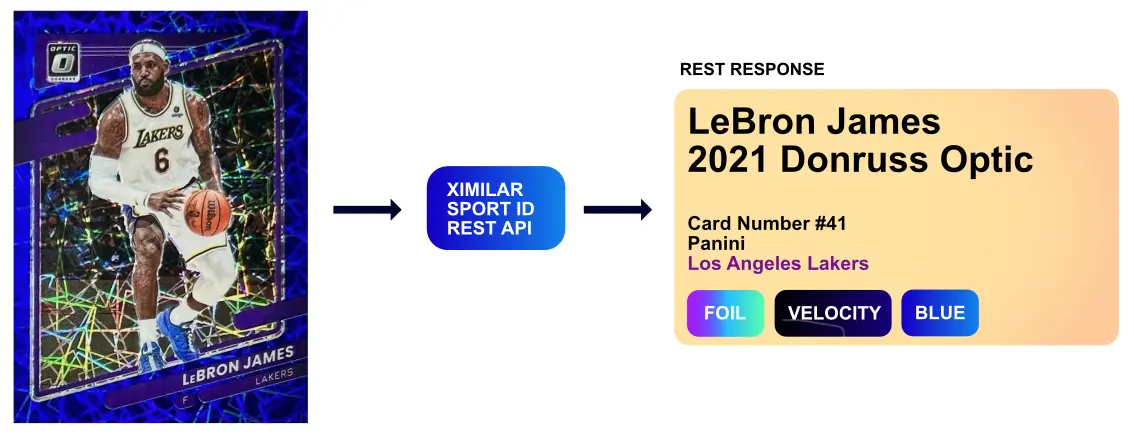
The API response will be as follows:
- When the system succesfuly indetifies the card, it will return you full identification. You will get a list of features such as the name of the player/person, the name of the set, card number, company, team and features like foil, autograph, colour and more. It is also able to generate URL links for eBay searches so you can check the card values or purchase them directly.
- If we are not sure about the identification (or we don’t have a specific card in our system) the system will return empty search results. In such case, feel free to ask for support.
How AI Sports Cards Identification Works?
Our identification system uses advanced machine learning models with smart algorithms for post-processing. The system is a complex flow of models that incorporates visual search. We trained the system on a large amount of data, curated by our own annotation team.
First, we identify the location of the card in your photo. Second, we do multiple AI analyses of the card to identify whether it has autograph and more. The third step is to find the card in our collection with visual search (reverse image search). Lastly, we use AI to rerank the results to make them as precise as possible.
What Sports Cards Can Ximilar Identify?
Our sports cards database contains a few million cards. Of course, this is just a small subset of all collectible cards that were produced. Right now we focus on 6 main domains: Baseball cards, Football cards, Basketball cards, Hockey cards, Soccer and MMA, and the list expands based on demand. We continually add more data and improve the system.
We try to track and include new releases every month. If you see that we are missing some cards and you have the collection, let us know. We can agree on adding them to training data and giving you a discount on API requests. Since we want to build the most accurate system for card identification in the world, we are always looking for ways to gather more cards and improve the software’s accuracy.
Who Will Benefit From AI-Powered Sports Cards Identifier?
Access to our REST API can improve your position in the market especially if:
You own e-commerce sites/marketplaces that buy & sell cards – If you have your own shop, site or market for people who collect cards, this solution can boost your traffic and sales.
You are planning to design and publish your own collector app and need an all-in-one API for the recognition and grading of cards.
You want to manage, organize and add data to your own card collection.
Is My Data Safe?
Yes. First of all, we don’t save the analysed images. We don’t even have so much storage capacity to store each analysed image, photo, scan and screen you add to your collection. Once our system processes an image, it removes it from the memory. Also, GDPR applies to all photos that enter our system. Read more in our FAQs.
How Fast is the System, Can I Connect it to a Scanner?
The system can identify one card scan in one second. You can connect it to any card scanner available in the market. The scanning outputs the cards into the folders, to which you can apply a script for card identification.
Sports Cards Recognition Apps You Can Build With Our API
Here are a few ideas for apps that you can build with our Sport Card Identifier and REST API:
Automatic card scanning system – create a simple script that will be connected to our API and your scanners like Fujitsu fi-8170. The system will be able to document your cards with incredible speed. Several of our customers are already organizing their collections of TCGs (like Magic The Gathering or Pokémon) and adding new cards on the go.
Price checking app or portfolio analysis – create your phone app alternative to Ludex or CollX. Start documenting the cards by taking pictures and grading your trading card collection. Our system can provide card IDs, pre-grade cards, and search them in an online marketplace. Easily connect with other collectors, purchase & sell the cards. Test our system’s ability to provide URLs to marketplaces here.
Analysing eBay submission – would you like to know what your card’s worth and how many are currently available in the market? For how much was the card sold in the past? Track the price of the card over time? Or what is the card population? With our technology, you can build a system that can analyse it.
AI for Trading Cards and Collectors
So this is our latest narrow AI service for the collector community. It is quite easy to integrate it into any system. You can use it for automatic documentation of your collection or simply to list your cards on online markets.
For more information, contact us via chat or contact page, and we can schedule a call with you and talk about the technical and business details. If you want to go straight and implement it, take look at our developer’s API documentation and don’t hesitate to ask for guidance anytime.
Right now we are also working on Comics identification (Comic book, magazines and manga). If you would like to hear more then just contact us via email or chat.
Tags & Themes
Related Articles
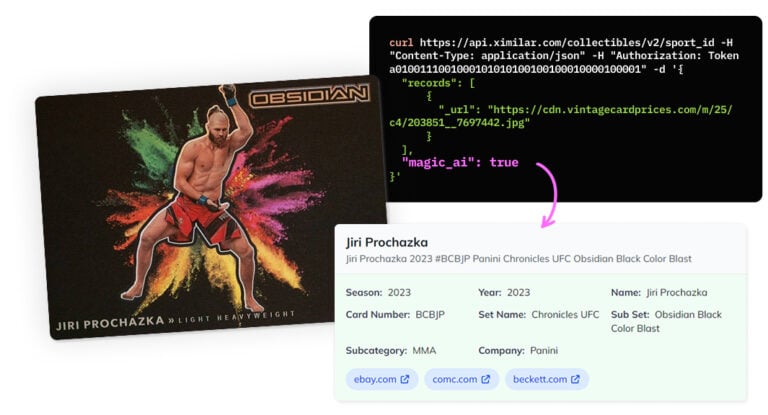
Recognize New & Rare Cards With AI Sports Card Identification
With millions of cards and variations, even the best databases miss some. We refined our sports cards recognition to identify cards even when no match exists.
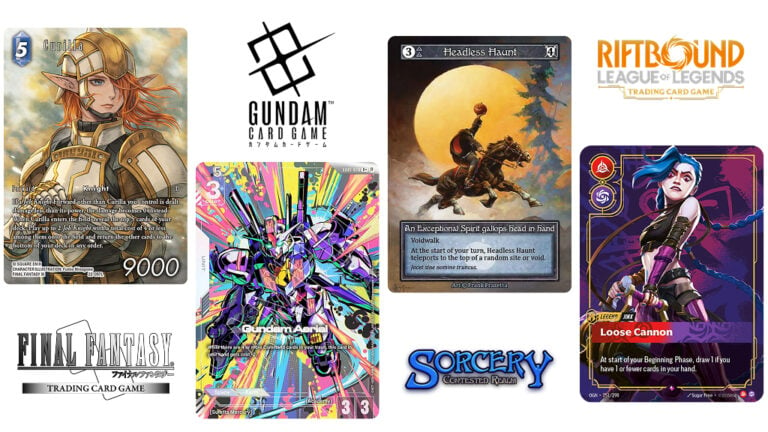
Final Fantasy, Sorcery, Gundam & Riftbound Added to Our Recognition System
Ximilar’s trading card game recognition system now supports Final Fantasy, Sorcery: Contested Realm, Gundam, and Riftbound. Let’s see it in action!

Ximilar Now Combines Visual and Text-to-Image Search
E-commerce retailers using our search engine now have access to multilingual text search as well.
